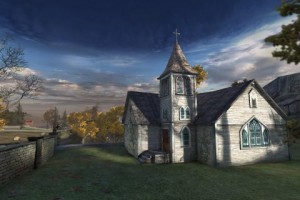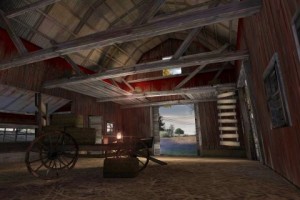 Let’s start off by getting your take on what the “dream:scape” is, exactly. What I loved most about the game is how subjective its world felt to me, and how my initial suspicions about the dream:scape’s nature were called into question by a major revelation that awaits the player toward the end. Is the underlying nature of Wilson’s subconscious adventure something that you wanted to leave up to the player’s interpretation, or do you have a specific truth in mind?
Let’s start off by getting your take on what the “dream:scape” is, exactly. What I loved most about the game is how subjective its world felt to me, and how my initial suspicions about the dream:scape’s nature were called into question by a major revelation that awaits the player toward the end. Is the underlying nature of Wilson’s subconscious adventure something that you wanted to leave up to the player’s interpretation, or do you have a specific truth in mind?
My main intention with Dream:scape was to offer a theory about what happens in the mind of a coma patient. In the case of Wilson, he is given a chance to come to grips with some dark truths that his conscious mind has always resisted. In the cold, surreal light of the dream:scape, he confronts a mystery that has haunted his whole life, and finds that he has always known what really happened, but denied the truth of it.
A secondary theme, of course, is the suggestion that all humans are connected on some mysterious level. Using this connection, Wilson is able to enter the subconscious of his nemesis and set a particular form of revenge into motion. Apart from that, there is certainly a degree of subjectivity at work throughout the story, particularly in the climactic scene. Many players will come up with their own interpretations of what it all means, and that is exactly what I aimed for.
 Which came first – the story idea or your interest in learning how to use the Unreal Development Kit? How did one lead into the other?
Which came first – the story idea or your interest in learning how to use the Unreal Development Kit? How did one lead into the other?
Honestly, the story grew out of some initial explorations of the Unreal development experience. My first two experimental models were a gnarled tree and an old cabin. I placed them both into an environment and thought they evoked a very interesting scene, ripe with story possibilities. I imagined a sort of history there — a young girl and boy hiding in the abandoned cabin. What were they hiding from? What ever became of them? It was from this that the entire dream:scape story developed.
The length of this project’s development cycle is really something – just January to April 2011, excluding bug fixing and polishing, if I’ve got that right? Given the quality of the product made in that time frame, one can only suspect you’ve had a lot of previous game design experience, not to mention professional writing experience between you and Jane Kalmes. Are either of these suspicions true, or are we literally looking at the product of raw inspiration and one extremely user-friendly game development suite?
I’ve had experience in nearly every aspect of game creation, while never actually being involved with any actual games thus far. I developed a love of low-poly modeling and character animation while working on several web 3D applications, where I also developed my texture design skills. As a writer (my book, The Riverhouse, was recently an amazon best-seller), I love the idea of an engaging but minimalist story told through short narrative segments, which is ideal for a game project. Thus, while the UDK interface was pretty easy for me to pick up, I did come in with a lot of necessary skillsets intact, otherwise this would have been a much longer project.
 It’s so awesome that you recruited help from relatives, judging from the credits. Can you tell us any interesting stories on that subject? Was it a big proposition made at a serious kitchen table gathering, or something that just naturally happened as family members became interested in the project?
It’s so awesome that you recruited help from relatives, judging from the credits. Can you tell us any interesting stories on that subject? Was it a big proposition made at a serious kitchen table gathering, or something that just naturally happened as family members became interested in the project?
One story was that I had originally asked my five-year-old daughter Greer to read the lines for young Amelia. When the time came to record, though, she had no interest whatsoever. My eight-year-old son Zane was nearby, so I asked him to pinch-hit. “Just try to read it like a girl”, I told him. He played along very well, and with a little digital manipulation, his reading was good enough to make it into the final game. Initially, I intended to record everything professionally, but when time got tight, I ended up recording all the lines on my iPhone. The lines recorded by Carol Mertz (adult Amelia and the Scarecrow Guide) were recorded in her closet on her iPhone. It worked so well that we never even had to meet in person during the development process. I just emailed her the dialogue, along with some direction, and she sent me back her recordings. It all worked eerily well.
One of the first things sure to strike any Dream:scape player is how beautifully rendered its game world is. Did you make all the non-audio resources (models, textures, etc) from scratch? If so, what software did you use?
I am pleased to say that nearly everything in the game, from the models and textures to the musical score and voice acting, is almost entirely original and created for Dream:scape. A few of the trees and rock textures did come as freebies with UDK, but everything else was created from scratch as needed. I built everything in Autodesk Maya, painted and composited all textures in Photoshop, and did endless period research via good old Google image search.


